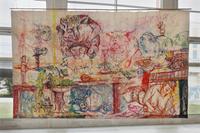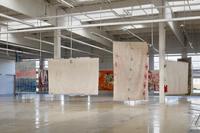Marek Pražák: The Twelve Commandments
An epic of the 21st century in twelve large-format paintings.
←→
Marek Pražák has often been described – and describes himself – as a universal artist; this could be because he moves between genres and his relationship to the world is distinctly performative. Pražák is a painter, sculptor, performer, poet, musician and designer. His versatility corresponds to his vision of the “Ostrava synthesis”, which he imagines as a synergy of “artists and cultivated creatures” into a unified resonance resulting from the fusion of art, music, image and word. The exhibition will highlight painting as one strand of his versatility and will follow Pražák’s multifaceted exploration of modern humans and society from the perspective of both historical and cosmic time and in the uncertainties of contemporary existence. Are the ruins serving as a base for our identities able to bear our demands for a good life, for a better future for society? What forces, powers and energies are affecting the good life of people on Earth?
For The Twelve Commandments exhibition, Marek Pražák has prepared a new cycle of twelve large-format paintings, a kind of universal epic of the 21st century and its pre-modern prerequisites. He observes old stories growing and transforming into new ones, and encountering what he himself can observe or find in the parallel world of culture and information. He is interested in identifying the laws, patterns, agreements, conventions, obligations, rights, habits and vices affecting the distribution of world power and the lives of individuals. But this is not just a nihilistic view of a dark future and a critique of the poor state of the things; it is also a vision of the transformative capacity of culture, art and aesthetics as a way of cultivating perception and action, and a vision of a mental and sensory reconfiguration of the way we experience and enjoy the world.
Marek Pražák is interested in big stories, historical, biblical, mythical, mythological and conspiratorial, Inca legends, chthonic deities, Christianity, colonization, racial differentiation, nationalism, aging, illness, poverty, fear and death. He observes the effects of these big planetary histories on smaller ones and looks for their present offshoots in the streets of the city, in Ostrava. Present generations have inherited the problems accumulated by the generations before us. Still, only a handful of the population is aware or admits this through their actions. Due to our lifestyle, the generations coming after us will live a fundamentally different life. Yet, Pražák’s “frescoes” are not just a postmodern notice board of stories floating loosely on the surface of the painting. They are organized according to various geometric and three-dimensional patterns, for example in concentric fields, centrally or axially.
Pražák wrote me about the section dedicated to old age: “Death is my everyday essential subject, as a part of life and knowledge; it too needs compassion, love and understanding, it is a being.” Similarly, he bestows the forms of beings on other parts of human life: Allegorical or symbolic, representing principles and phenomena, as well as quite concrete, representing examples or evidence of them. The bearers of the stories are mostly representative figures drawn from periods of transition. For instance, in the first opus, “Thou Shalt Not Grow Old,” the Apache chief and shaman Geronimo represents the fate of his tribe in a stage of final subjugation. He himself died of pneumonia, having fallen from his horse into the water under the influence of alcohol. In the opus “Thou Shalt Not Shatter,” Martin Luther King drives the spike of knowledge into the head of Da Vinci’s St. John the Baptist. Below that, a Nordic woman measures Musk’s head, while Gates and Bezos are waiting nearby. Skull measurements, a phrenological method for distinguishing races, is employed here as a divisive method of human categorization and exclusion. As the artist says, “When the earth cracks, the Reptoids and other creatures of the underground kingdom get out to avenge the disgruntled Mother Earth, Pachacama, to punish the wayward mankind” – the story of mankind and cosmic civilizations unfolds from the left corner of the painting, with a competing central head of religion and instruments of torture in the middle. Thus the commandment “Thou Shalt Not Reptiliate” unfolds in great detail.
This extensive work of painting and drawing is not expressly intuitive in nature. Like the format it resembles – a fresco – it is basically educational and based on long research of subjects and history. It is a real fresco with portraits of real people of the present and past and their centuries-old, real problems. Portrayed are the flamboyant romantic Karel Hynek Mácha in the section on old age and aging, John Brown in the opus on race and racism, or Ku Klux Klan founder Nathan Bedford Forrest, and very many more. This no longer concerns “just” Ostrava, the “Sick City”, and the “Silesian Hallads” (songs from the Ostrava slag heaps), but the whole of Chthulucene, a planet ruled by reptilians and inhabited by mythical creatures with a realistic foundation.
These paintings are not made for contemplation in the privacy of one’s home, they are meant to be set up for the public as mirrors, as an educational projection that resembles the facade of a building, an ark, a circus tent, and also as a message about society on planet Earth. The perspective is different from the civic, subjective one, but flashing by in these grand narratives are concrete details of today. An ethical message and activist desire are painted within them. The grandeur and sublimity of the old medium of fresco, which the installation recalls, and the distinct aesthetic plane filled with brisk, stylistically varied drawing and sophisticated colour composition, only seemingly delirious, are not meant to be autotelic – I would say that the artist is trying to open our senses through a moment of wonder and show us the recurring patterns of destructive human action. In this vast panorama reminding of Luděk Marold and showing the ruins of the past, we are supposed to touch the things that we as mankind have already experienced in order to get a different understanding of the world around us; not just keep brushing off the skeletal remains that try to reveal and suggest that the past is not at all distant from us in time; on the contrary, it still permeates us in different places and with different intensities.
Marek Pražák is a sculptor, painter, musician, author, performer, designer and multimedia artist connected with Ostrava – not only as the site of his intense cultural and social engagement. Ostrava is also a frequent subject of his visual, sound, textual and other works. His work can be seen in several locations in the public space of Ostrava. Pražák graduated from the Academy of Architecture, Art and Design in Prague: between 1986–1992, he studied at the Department of Machine and Tool Shaping led by Zdeněk Kovář and Pavel Škarka at the detached workplace in Zlín. Besides his non-commissioned work and exhibition activities, he also makes artistic realizations in architecture for private and institutional clients. He has done stage design, working for theatre, television and film. He has been a member of several musical groups (Svoz řepy, Norská Trojka, Elvis Presley Epileptic Band and Elvis Sisters, Barovka, Duo Kotari and the Ostrava cabaret Návrat mistrů zábavy). He is the author of a number of poems and collections, such as Hallad on the Oil City and Silesian Hallads.
Special thanks to the Ministry of Culture of the Czech Republic and Moravian-Silesian Region.









